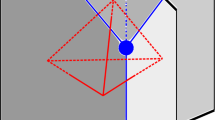Summary
We present a classical theory of the interaction of a spinor field with the electromagnetic field in which the potentials enter only implicitly through the Maxwell tensor. This theory differs from previous ones in that it is both manifestly covariant under Lorentz transformations and local in time. We then carry out the quantization without a need to introduce special terms or an indefinite metric, and proceed to formulate the perturbation expansion of theS-matrix.
Riassunto
Si presenta una teoria classica dell’interazione di un campo spinoriale col campo elettromagnetico in cui i potenziali entrano solo implicitamente tramite il tensore di Maxwell. Questa teoria differisce dalle precedenti in quanto è manifestamente covariante per trasformazioni di Lorentz e locale nel tempo. Si può eseguire la quantizzazione senza che ci sia bisogno di introdurre termini speciali o una metrica indefinita, e si formula poi lo sviluppo perturbativo della matriceS.
Реэюме
Мы предлагаем классическую теорию вэаимодействия спинорного поля с злектромагнитным полем, в котором потенциалы входят только череэ тенэор Максвелла. Эта теория отличается от предыдуших тем, что она и явно ковариантна относительно преобраэований Лорентца и локальна по времени. Затем мы проводим квантование беэ необходимости введения специальных членов или индефинитной метрики, и приступаем к формировке пертурбационного раэложения S-матрицы.
Similar content being viewed by others
References
E. Fermi:Atti Accad. Naz. Lincei Rend. Classe Sci. Fis. Mat. e Nat.,9. 881 (1929).
K. Bleuler:Helv. Phys. Acta,23, 567 (1950);S. N. Gupta:Proc. Phys. Soc., A63, 681 (1950).
P. G. Bergmann:Nuovo Cimento,3, 1177 (1956).
I. Goldberg:Phys. Rev.,112, 1361 (1958).
I. Goldberg:Phys. Rev.,139, B 1665 (1965).
S. Mandelstam:Ann. of Phys.,19, 1 (1962).
J. M. Jauch andF. Rohrlich:The Theory of Photons and Electrons (Reading, Mass., 1955).
P. G. Bergmann andI. Goldberg:Phys. Rev.,98, 531 (1955).
P. A. M. Dirac:Proc. Roy. Soc.,235, 138 (1950).
J. Rzewuski:Field Theory, part I (Warsaw, 1964), p. 137;G. N. Fleming:Journ. Math. Phys.,7, 1959 (1966).
First-class constraints(11) have vanishing Poisson brackets with all other constraints; others are called second-class constraints. It can be seen that eqs. (24) and (27) are first class, while eqs. (28) and (29) are second class.
P. A. M. Dirac:Can. Journ. Math.,2, 129 (1950);3, 1 (1951).
J. Schwinger:Phys. Rev. Lett.,3, 296 (1959);I. Goldberg andE. Marx:Nucl. Phys., B3, 25 (1967).
This is the commutator given bySchwinger in ref. (13), eq. (3.14). Similar results are found in ref. (14), where a Coulomb gauge is employed.
J. Schwinger:Phys. Rev.,74, 1439 (1948).
J. J. Sakurai:Advanced Quantum Mechanics (Reading, Mass., 1967).
N. N. Bogoliubov andD. V. Shirkov:Introduction to the Theory of Quantized Fields (New York, 1959), p. 131.
K. Johnson:Phys. Rev.,112, 1367 (1958).
Author information
Authors and Affiliations
Rights and permissions
About this article
Cite this article
Goldberg, I., Marx, E. Gauge-independent quantum electrodynamics. Nuovo Cimento B (1965-1970) 57, 485–502 (1968). https://doi.org/10.1007/BF02710215
Received:
Published:
Issue Date:
DOI: https://doi.org/10.1007/BF02710215




